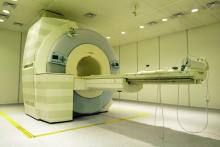A combination of magnetic resonance elastography and blood levels of fibrosis-4 index (MEFIB) outperformed FibroScan-AST (FAST) in determining the presence of significant fibrosis among patients with nonalcoholic fatty liver disease (NAFLD), according to a new prospective cohort analysis.
Liver fibrosis is the most important prognostic factor for NAFLD, but the invasiveness, propensity for sampling error, and interoperator variability of biopsy have prompted efforts to develop alternatives. FAST, which uses vibration-controlled transient elastography (VCTE), controlled attenuation parameter (CAP), and aspartate aminotransferase levels, and MEFIB have been developed as candidates, but they had not been directly compared in screening. The findings suggest that MEFIB may be a better tool for identifying NAFLD patients at heightened risk of nonalcoholic steatohepatitis (NASH), as well as which patients could be candidates for pharmacotherapy interventions and clinical trials.
Although there are no drugs currently approved for high-risk NAFLD patients, many clinical trials are underway. Patients with stage 2 or higher fibrosis are candidates for clinical trials, but many trials experience a high screening failure rate. A noninvasive method that can identify clinical trial candidates while avoiding liver biopsy would be a welcome addition, Nobuharu Tamaki, MD, PhD, of the NAFLD Research Center, division of gastroenterology and hepatology, department of medicine, at the University of California, San Diego, and colleagues explained in Hepatology.
“We suspect that these are the patients; if there is going to be a drug approved, it will be for this patient population. So it’s important for prognosis, but it’s also important potentially for future treatment with new drugs,” said Zobair Younossi, MD, who was asked to comment on the study.
The researchers examined a cohort of 234 consecutive adults at UCSD and 314 consecutive adults at Yokohama (Japan) City University who underwent liver biopsy, magnetic resonance elastography (MRE), VCTE, and CAP assessment.
Significant fibrosis was found in 29.5% of the UCSD cohort and 66.2% of the Yokohama cohort.* MEFIB had a higher area under the receiver operating characteristic curve than FAST in the UCSD cohort (0.860 vs. 0.757; P = .005) and the Yokohama cohort (0.899 vs. 0.724; P < .001).
When the researchers employed MEFIB as a rule-in criteria (MRE value ≥3.3 kPa and FIB-4 ≥1.6), MEFIB had a positive predictive value of 91.2% in the UCSD cohort and 96.0% in the Yokohama cohort, versus 74.2% and 89.2% for FAST (≥0.67), respectively. Rule-out criteria included MRE less than 3.3 kPa and Fib-4 less than1.6 for MEFIB, as well as FAST of 0.35 or less; with those parameters, negative predictive value for significant fibrosis was 92.8% in the UCSD group and 85.6% in the Yokohama group for MEFIB, and 88.3% and 57.8% for FAST, respectively.
Most existing noninvasive tests do a pretty good job of excluding advanced fibrosis, but they don’t perform as well at identifying those with cirrhosis, according to Dr. Younossi. He added that MEFIB isn’t suitable for general population screening, but rather for case finding, in which it can be used to identify patients who are likely to have high risk for fibrosis. “Nevertheless, it seems like the combination of FIB-4 and MRE has very good performance for identifying and excluding NAFLD patients with moderate to advance fibrosis, at least in the two cohorts that were looked at,” said Dr. Younossi.
However, Dr. Younossi noted some potential limitations to the study. Both cohorts were from referral centers, making it likely that the included patients have higher prevalences of fibrosis than a typical practice patient population, making it important to validate the findings in a real-world setting. The approach also relies on magnetic resonance technology, which is costly and may not be readily available. “We need to potentially find other, simpler noninvasive test combinations that are easier to do than MRE,” said Dr. Younossi.
Several authors disclosed ties with numerous pharmaceutical and device companies, including Pfizer, AstraZeneca, and Siemens. Dr. Younossi has no relevant financial disclosures.
Correction, 1/18/22: An earlier version of this article misstated the percentage of each cohort that had significant fibrosis.




